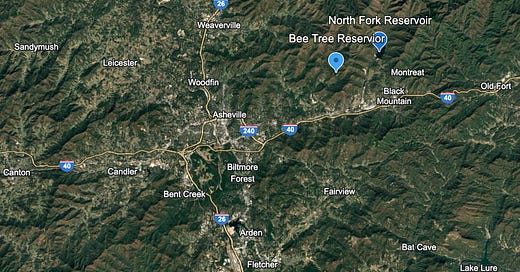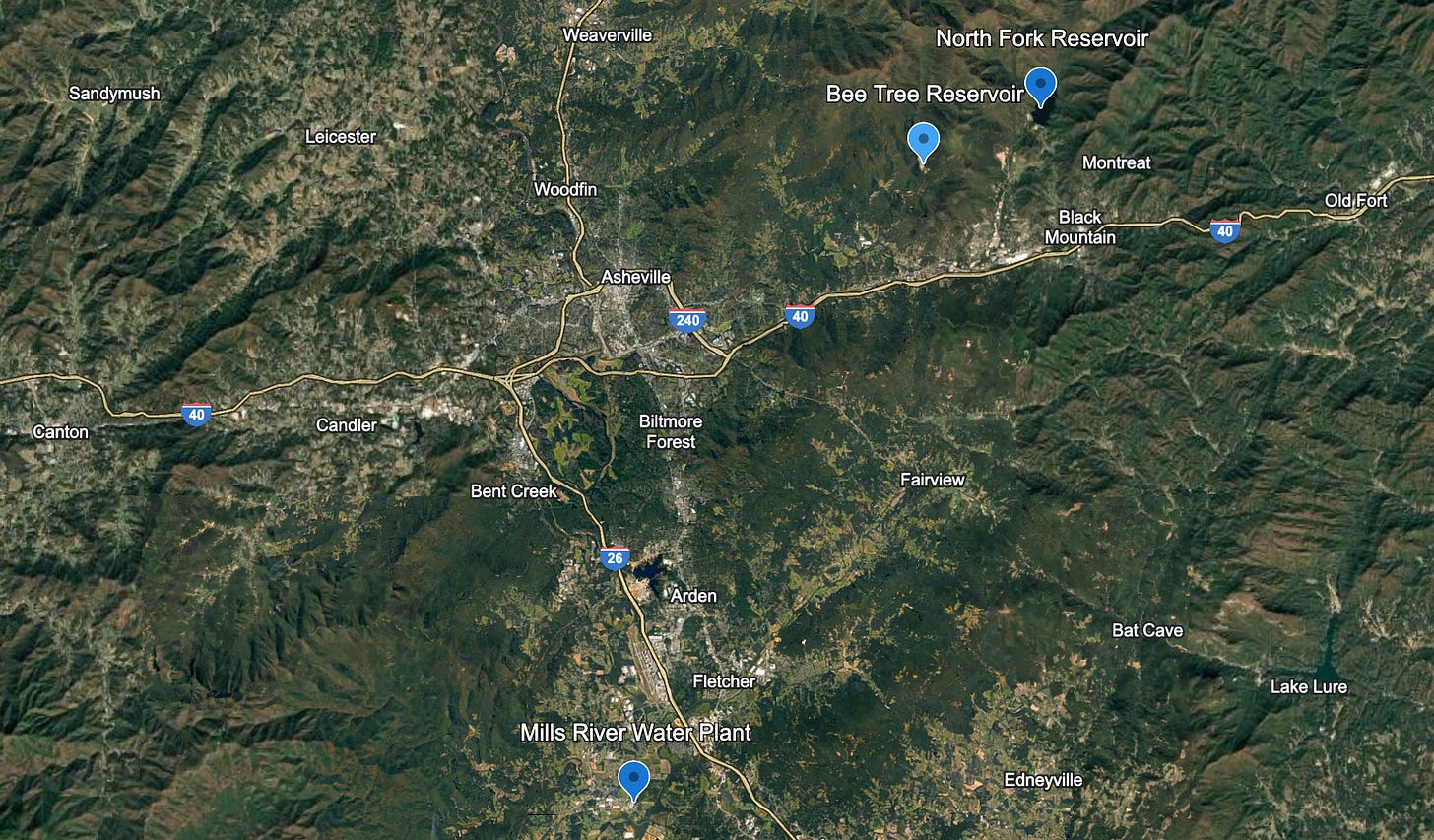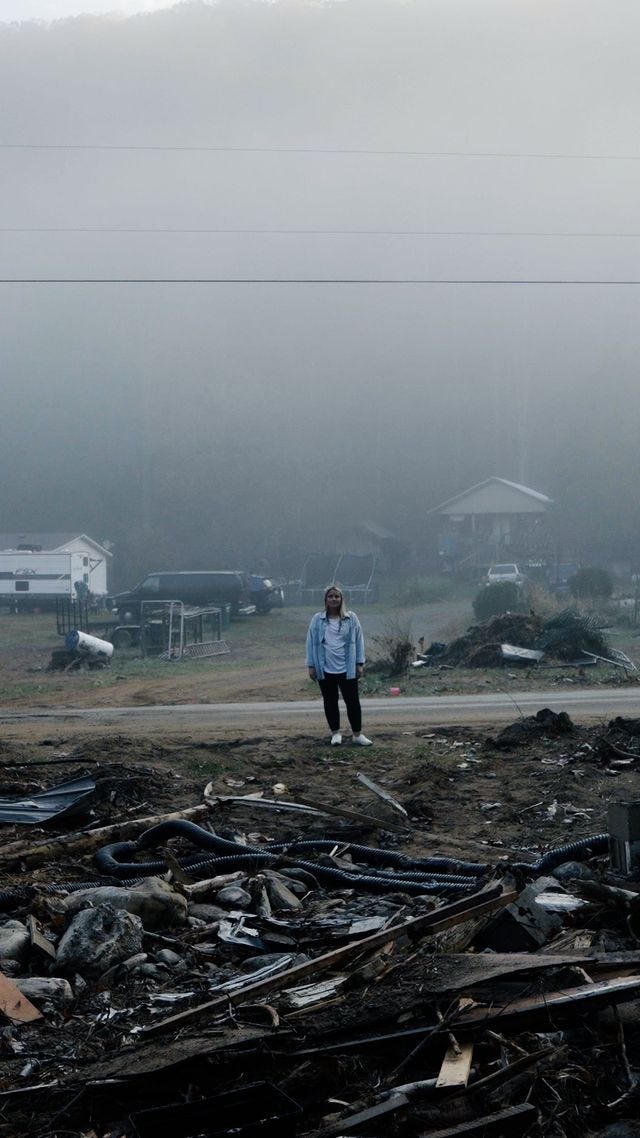Why restoring clean water is taking so long
Plus: Lead found in Asheville’s water supply; Mountain summer camps work on repairs; I-40 to partially reopen by New Year’s Day; Over 400 dump truck loads of trash removed from Lake Lure
You’re reading Mountain Updates, a free pop-up newsletter from The Charlotte Ledger examining the crisis and recovery in the N.C. mountains. Ledger subscribers can add Mountain Updates on their “My Account” page.
Sign up for free:
Asheville says clean water might be restored by Tuesday. For residents, it has been a long 7 weeks.
I’m looking forward to the day this newsletter begins with good news about fully operational water systems across Western North Carolina. Unfortunately, today is not that day.
Seven weeks after Tropical Storm Helene, clean tap water is still a luxury many people in the hardest-hit areas don’t have.
The good news is that there’s hope that clean water could be restored to many folks soon: Asheville’s water department said today that water from the North Fork Reservoir, the city’s main water source, might be drinkable by Tuesday.
Let’s look a little deeper into why it’s taking so long.
In the Buncombe County area, people get their water from one of three treatment plants. The big one is at the North Fork Reservoir, which provides water for 80% of customers — about 160,000 people — in Buncombe and Henderson counties. It’s under a boil water advisory. Water comes through the pipes, but it’s not safe to drink.
The remaining 20% of the city’s water system typically comes from the Mills River Water Plant that serves southern Buncombe County and the William DeBruhl Water Plant at the Bee Tree Reservoir in eastern Buncombe County. (And, of course, some people also have private wells.)
But as of Sept. 28, Bee Tree’s treatment plant is completely offline. The Bee Tree neighborhood was one of the hardest-hit areas in Western North Carolina (I shared some images in Tuesday’s newsletter after driving through the area last weekend), and during the height of the flooding, the area was under a mandatory evacuation order. The dam was rumored to be near centimeters from failing, which would have resulted in catastrophic damage. It holds about 520 million gallons of water.
Bee Tree Reservoir and the Mills River Water Plant provide water for a combined 20% of customers in Buncombe County. North Fork Reservoir provides water for the remaining 80% of customers in Asheville and Buncombe and Henderson counties. (Photo from Google Maps)
Fortunately, the dam held, but that doesn’t mean the reservoir didn’t suffer. The storm triggered landslides and major flooding, which filled both reservoirs with large amounts of sediment and debris. To give you an idea of how much, consider the turbidity.
“Turbidity” refers to how cloudy the water is, so in this case, how much sediment is in the water. People of Western North Carolina have become very familiar with this term over the past month and a half. (Mountain publications now use the term as though it is part of everyone’s vocabulary, as in this Asheville Watchdog headline: “March toward normal turbidity continues, as third coagulation treatment is underway.”)
Water treatment plants typically remove the sediment particles through a curtain filtration system, but when there’s too much sediment, it can damage the filtration system. That means treatment plants have to lower sediment levels through rounds of chemical treatments before they can push the water through the filters. Rain and high winds can disturb the sediment and slow down the process.
To put it in perspective, on Wednesday morning, the North Fork Reservoir’s turbidity levels were reported at 14.8 NTUs, according to the Asheville Watchdog, and the goal is to get it down to 1.5 or 2 NTUs before it can safely pass through the curtains. (NTU is short for “Nephelometric Turbidity Units.” Drinking water is ideally below 1 NTU.) Immediately after the hurricane, it was recorded at 79 NTUs.
As of about a week ago, the Bee Tree Reservoir's turbidity was reading at 140 NTUs, the Asheville Watchdog reported. It started at about 200 NTUs immediately following Helene.
Until the Bee Tree Reservoir is back up and running, the other treatment plants are filling in. Fortunately, the Mills River plant sustained little damage and is fully operational. But it’s not a long-term solution.
That’s not to mention damaged water pipes and connections across the region, which are also contributing to delays in restoring water. I imagine the cold weather ahead isn’t going to make any part of this process easier.
Here are the latest updates:
Lead found in Asheville’s water supply: Lead contamination has been detected in water samples at seven schools and several homes across Buncombe County due to older plumbing and challenges following Tropical Storm Helene. Schools have implemented precautions, including covering water fountains and installing certified filters. Residents with pre-1988 plumbing are advised to use bottled water or take precautions when boiling tap water. The water source itself remains lead-free. (WLOS)
Mountain summer camps are in cleanup mode: Helene caused significant damage to more than a dozen summer camps in Western North Carolina, with downed trees, damaged buildings and blocked trails. Community volunteers and camp alumni are aiding recovery efforts to get camps and their surrounding communities ready for the summer season. Camps are also hosting relief workers and volunteer groups who are helping the community. (Ledger 🔒)
I-40 repairs update: The North Carolina Department of Transportation says it's on track for a partial reopening of I-40 near the North Carolina-Tennessee border by New Year's Day. NCDOT plans to reopen two lanes — one in each direction — using temporary stabilization methods like soil nails and shotcrete. A permanent fix, involving stronger retaining walls, is being planned with federal approval for an accelerated construction method. (WLOS)
Lake Lure makes cleanup progress: After Helene, Lake Lure looked more like a body of trash than water, but thanks to cleanup efforts, 5,598 cubic yards of debris has been removed (equivalent to 407 dump truck loads). Camp Lurecrest has provided lodging for over 500 volunteers aiding the recovery and continues to support efforts, including heating supplies for residents in cold conditions. The U.S. Army Corps of Engineers has made significant progress using floating barges for debris collection, aiming to clear the lake fully within three weeks. (WLOS)
Free college day for WNC seniors: The University of North Carolina system will host a free College Day for high school seniors and families affected by Hurricane Helene on Sunday from noon to 4 p.m. at UNC Asheville’s Highsmith Student Union. Attendees can meet with university representatives for assistance with applications and financial aid. (WLOS)
WATCH: Camper vans and trailers donated to people who lost their homes
Photo of the day: Statue of debris in River Arts District gives ‘hope’
Asheville’s River Arts District was demolished in Helene’s flooding, washing away homes and businesses, including art galleries where many local artists sold their work. This photo was taken on Nov. 10, more than a month later. (Photo courtesy of Rey Castillo Jr.)
—
In case you missed it: Podcast on the recovery in the N.C. mountains
The Charlotte Ledger’s Tony Mecia talks with reporter Lindsey Banks, the writer of this Mountain Updates newsletter, about the crisis and recovery in the North Carolina mountains.
It’s available on The Ledger’s website as well as on podcast platforms Spotify, Apple Podcasts and more (under “The Charlotte Ledger Podcast”).
—
Lindsey Banks, a native of the Buncombe County town of Swannanoa, is a staff reporter with The Charlotte Ledger. Reach her at lindsey@cltledger.com.
How to help
Many organizations have deployed groups across the region, tasked with distributing food, water and supplies. You can donate to their efforts at the links below.
Hearts with Hands, a local disaster relief organization, has a donation page to provide food, supplies and water.
United Way of North Carolina has established a fund to help residents affected by the flooding.
MANNA Foodbank, which serves 16 counties in Western North Carolina, is accepting food, supplies and monetary donations. The organization’s warehouse on Swannanoa River Road in Asheville was damaged by the hurricane.
The American Red Cross is accepting donations to help residents in the Southeast.
Samaritan’s Purse, which is headquartered in Boone, is scheduling volunteers to help with debris cleanup.
Operation Blessing has a donation page to provide food, supplies and water.
E4E Relief, a Charlotte-headquartered provider of emergency financial relief programs on behalf of corporations, is accepting donations for their newly established Hurricane Helene Community Fund, offering financial support to individuals with long-term impacts from Hurricane Helene.
Need to sign up for this e-newsletter? We offer a free version, as well as paid memberships for full access to all of our local newsletters:
➡️ Opt in or out of different newsletters on your “My Account” page.
➡️ Learn more about The Charlotte Ledger
The Charlotte Ledger is a locally owned media company that delivers smart and essential news through e-newsletters and on a website. We strive for fairness and accuracy and will correct all known errors. The content reflects the independent editorial judgment of The Charlotte Ledger. Any advertising, paid marketing, or sponsored content will be clearly labeled.
Like what we are doing? Feel free to forward this along and to tell a friend.
Social media: On Facebook, Instagram, Twitter and LinkedIn.
Sponsorship information/customer service: email support@cltledger.com.
Executive editor: Tony Mecia; Managing editor: Cristina Bolling; Staff writer: Lindsey Banks; Business manager: Brie Chrisman







